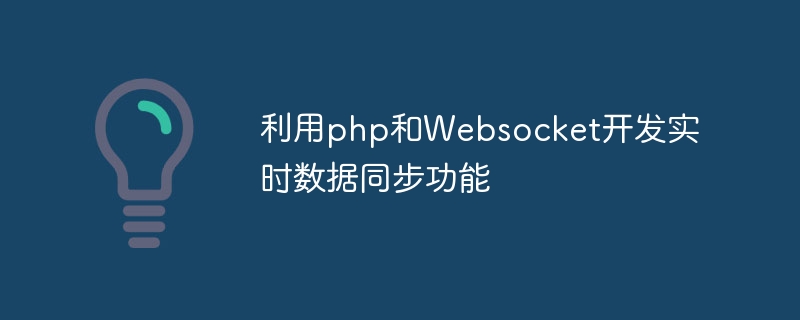Home >Backend Development >PHP Tutorial >Develop real-time data synchronization function using php and Websocket
Develop real-time data synchronization function using php and Websocket
- WBOYWBOYWBOYWBOYWBOYWBOYWBOYWBOYWBOYWBOYWBOYWBOYWBOriginal
- 2023-12-02 09:17:191491browse

Use PHP and WebSocket to develop real-time data synchronization function
Text:
With the rapid development of the Internet, the demand for real-time data interaction is also increasing The bigger. Traditional page refresh cannot meet users' requirements for real-time data update, so WebSocket technology emerged, which provides a full-duplex communication method that can transfer data between the server and the client in real time. This article describes how to develop real-time data synchronization functionality using PHP and WebSocket technology.
1. Basic principles of WebSocket
WebSocket is a protocol based on the TCP protocol, but unlike the HTTP protocol, it can perform two-way data transmission after establishing a connection with the server. No need to keep making requests. This allows WebSocket to achieve real-time data synchronization.
2. WebSocket usage process
- Establish a WebSocket connection between the client and the server.
- The client sends an HTTP request to the server, which contains an Upgrade header, requiring the protocol to switch from HTTP to WebSocket.
- The server performs a protocol upgrade and switches the protocol from HTTP to WebSocket.
- Bidirectional data transmission begins between client and server.
3. Steps to develop real-time data synchronization function using PHP and WebSocket
- Ensure that the server environment supports WebSocket.
- Introduce a WebSocket server library into the project, such as php-websocket.
- Create a WebSocket server object and listen to the specified port.
require 'WebSocketServer.php';
$server = new WebSocketServer('127.0.0.1', 8000);
$server->run();- Register some event processing functions in the server object, such as connection establishment, message reception and other events.
$server->on('open', function ($server, $client) {
echo "建立连接
";
});
$server->on('message', function ($server, $client, $data) {
echo "接收到消息:$data
";
});
$server->on('close', function ($server, $client) {
echo "连接关闭
";
});- In the event processing function, write specific business logic. Received messages can be broadcast to all connected clients, or the data can be processed according to business needs.
// 广播消息给所有客户端
$server->on('message', function ($server, $client, $data) {
foreach ($server->getClients() as $sendClient) {
$sendClient->send($data);
}
});- Introduce the WebSocket JavaScript library on the client page and establish a WebSocket connection with the server.
<script src="https://cdn.jsdelivr.net/npm/vue/dist/vue.js"></script>
<script>
var ws = new WebSocket("ws://localhost:8000");
ws.onopen = function() {
console.log("连接已建立");
};
ws.onmessage = function(event) {
console.log("收到消息:" + event.data);
};
ws.onclose = function() {
console.log("连接已关闭");
};
</script>- Send data to the server through JavaScript code in the client page.
ws.send("Hello, server!");4. Summary
Through the above steps, we can easily develop real-time data synchronization function using PHP and WebSocket technology. WebSocket can realize real-time two-way communication between the server and the client, greatly improving the efficiency and real-time performance of data synchronization. When developing WebSocket, you need to pay attention to security and performance issues. Proper application of WebSocket technology can provide users with a better real-time experience.
The above is the detailed content of Develop real-time data synchronization function using php and Websocket. For more information, please follow other related articles on the PHP Chinese website!

